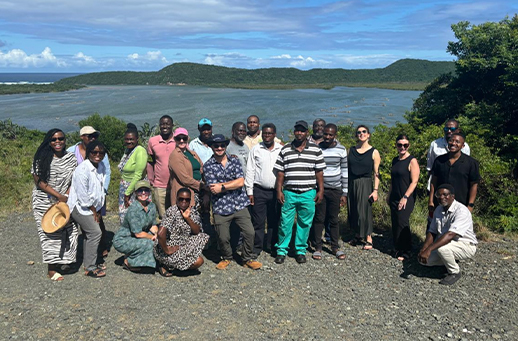Co-developing new funding proposal in South Africa and Mozambique

As part of the One Ocean Hub’s legacy programme, we have co-developed a new proposal to centre locally-led approaches to blue Carbon. In February 2025, the One Ocean Hub team engaged with Indigenous peoples and local coastal communities in Kosi Bay, South Africa, and on Inhaca Island, Mozambique, to co-develop a consortium and a proposal, entitled “BlueRoots: Connecting Local and Indigenous (roots) Knowledge to Coastal Ecosystem Valuation.” This was developed in response to the International Climate Initiative Thematic (IKI) Call: “From Blue Carbon to Blue Value – locally-led approaches for coastal marine ecosystem services”.

Indigenous peoples and local communities (IPLCs) in both these areas not only rely on seagrass beds, coral reefs and mangroves for their livelihoods and cultures, but they also play a crucial role in the conservation and management of these precious ecosystems. The proposed project seeks to address the specific challenges facing IPLCs, including women and youth in these local communities, when it comes to issues relating to coastal ecosystem valuation, biodiversity conservation and climate change adaptation.
Members of the consortium (which included Eduardo Mondlane University, Ocean Revolution, University of Cape Town, Peace Parks, Maputo National Park, Strathclyde University, United Nations Institute for Training and Research, Oceanographic Research Institute and the South African Department of Forestry, Fishery and the Environment) have long-standing relationships of co-producing and conducting research together with IPLCs in these sites, especially in marine sciences and policy-related fields on topics such as conservation, fisheries management, blue economy activities, tourism, and other resource governance.

Photo: Milica Prokic
The co-design workshops were essential for engaging with community members in Kosi Bay and Inhaca Island and respectually and contextually gauge if they were interested in being part of the funding proposal and if so, how they would like to shape it. This was done with the view to transforming business-as-usual approaches to biodiversity conservation planning and decision-making processes and to co-identifying necessary actions to implement community-based methods that ground climate and biodiversity discourse, processes and practices in the human rights and lived realities of IPLCs.
In Kosi Bay, where we have already co-developed art-based research on communities’ expertise in fish and ecosystem management, through the construction of traditional woven traps and palisade fish kraals for over 700 years, we met with members of the traditional council to discuss the possible aims of the project, as well as roles, responsibilities and how project funds can be allocated. Community members shared current challenges, opportunities and aspirations around the fish traps and the mangrove forests that should be integrated in the proposal.
In Inhaca Island, the team met with the Head Chief and his Council Members, as well as members of the broader community to discuss the possible aims and scope of the project. Community members emphasised the need for ongoing transparency, as they were wary of projects that promised a lot and delivered very little in terms of actual benefits to communities. This opened up a conversation with the One Ocean Hub team and other partners on how to transform coastal ecosystem valuation processes and biodiversity conservation in specific ways that improve the lives of coastal communities.
While we wait to hear about the next round of proposal writing, we wish to thank for, and celebrate, the conversations, learnings and new partnerships that emerged from these workshops.
Related SDGs: